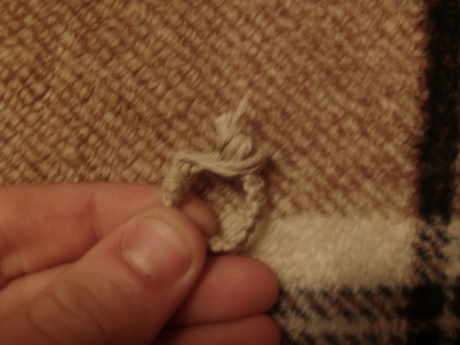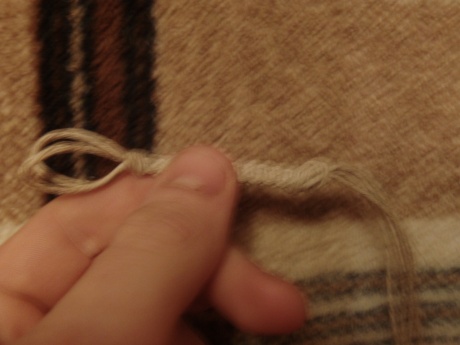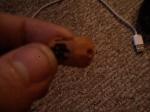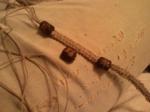Braiding a Piece of Hemp Jewelry – The Josephine Knot or the Pretzel Knot February 2, 2009
Posted by Rock One in Techniques.Tags: beads, carving, crafts, Handcrafted, hemp, hemp crafts, hemp jewelry, hippy, Ideas, jewelry, jewelry making, macrame, photos, pictures, Techniques
5 comments
The Josephine Knot (or the Pretzel Knot, as it’s oftentimes known) is more complicated than your basic square knot, but it can give a pretty sweet effect to a piece of jewelry. You can also make a piece of jewelry using solely this knot (I don’t personally like the way this looks, but it’s all up to you). Take a look at my other posts, and mix and match techniques and other ideas. Here is what this knot will look like:
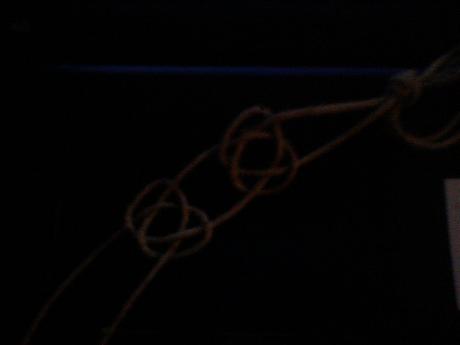
First of all, these instructions will only cover tying the Josephine knot. It’s up to you to figure out how to use it in your jewelry. However, it looks just as good using four cords, seperating the two leftmost and the two rightmost cords and treating each pair as a single cord. You will only need two pieces of hemp cord for this knot instead of the usual four. Bear with me, as they are terrible pictures I made in Paint, but it gets the job done. Not an incredibly hard knot to figure out. Just follow these pictures in order:
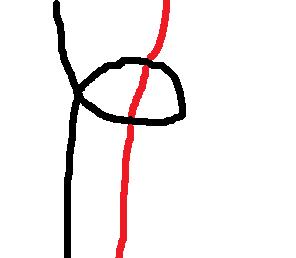
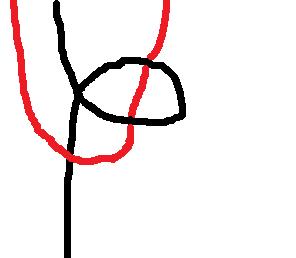
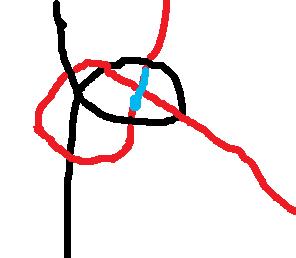
In the last picture, I changed a portion of the red line to blue to indicate which end of the cord goes under which. Holding the top of the cords, tighten the bottoms simultaneously. The knot should look like a pretzel. That’s it. Go ahead and try it out. Let me know if the pictures aren’t enough to figure it out. I can take some actual pictures, or a video. Good luck.
Make Your Own Wooden Kanji Beads January 29, 2009
Posted by Rock One in beads, Hemp Jewelry Supplies, Ideas, Make your own.Tags: beads, carving, crafts, Handcrafted, hemp, hemp crafts, hemp jewelry, hippy, Ideas, jewelry, jewelry making, macrame, photos, pictures, Techniques, woodworking
2 comments
If you’re like me, and sick of all the same generic beads floating around on everyone’s hemp necklaces, here’s a relatively easy (and very cheap) idea that will help you make your own.
First of all, I’d just like to throw it out there that I am by no means a good woodworker. Or a woodworker at all, for that matter. I just thought this one up and tried it out, and it actually turned out really cool. Here’s a picture of the finished product (as is the case with many of my pictures, please excuse the fact that they are not good. I took them with my phone, and some are pretty badly lit):
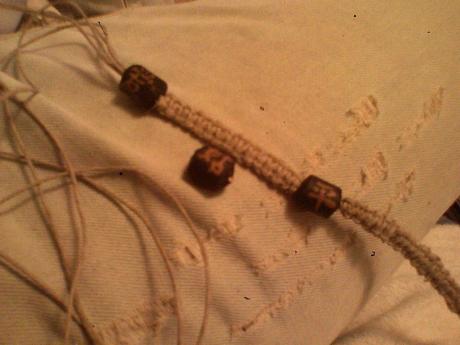
First off, you will need just a few things. You might already have some of these, but if you need to go out and buy them, it won’t cost much at all:
- Wooden dowel (these cost a matter of pennies at your local hardware store. Literally. Less than a dollar)
- Paint (any color, but make sure that it is for use on wood. The kind I used was less than a dollar a bottle. You can find it at Wal Mart or your local craft store)
- Carving tools (or just a small, durable knife. I got a set of about six carving tools at Wal Mart for less than five bucks)
- Toothpick (or anything small enough to do detail paint work on your beads. Personally, I carved down the handle of one of the cheap plastic paint brushes I was using. Worked just fine)
- Paintbrush (you probably don’t even need a paintbrush, just something to put paint over your beads. I would imagine that you could just wipe it on with a paper towel or something)
- Drill with small bit (or some other means of putting a hole in the middle of your beads. I own a Dremel tool, which cost me about 75 dollars. However, there are some models that are as cheap as thirty. You may already have a drill of some sort laying around with a small enough bit. Do what I do: improvise)
Once you have all the things you need, go ahead and start carving the beads out of the dowel. Make a small “V” groove all the way around the dowel, then just keep making the groove deeper and deeper until the bead comes apart from the rest of the dowel. Try your best not to let the bead break off. Here’s a (really bad) picture:
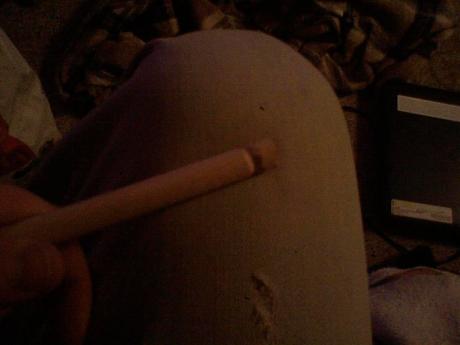
Go ahead and carve out three or four of these (or however many you want. It’s all up to you). Once you have this done, you will need to drill a hole through the middle of the beads (so you can put them on your jewelry). After that, it’s time to add your first layer of paint. When choosing your paint, it would be best to pick one dark color and one light color. I like dark, “earthy” colors, so I chose black and a light shade of brown. Paint the entire surface of the bead with one color, then let them dry. I strung them all on a piece of hemp cord, and tied each side of the cord to something.
Once the first layer of paint has dried, you can either put another coat of the same color on (I didn’t), or go ahead and pick out the symbols you want to put on them. I used kanji symbols (Chinese writing), but you can put whatever you want on them. If you opt to use kanji, here’s a link you can use to find some symbols: Tribalshapes.com.
Once you have symbols picked out, put some of the paint you have not used yet on a plate or something similar. Dip your toothpick in it, and carefully draw the symbols on the bead. Let this dry, and there you have it! Go ahead and add your beads to a necklacke or bracelet.
Notes:
-
You can sand the beads before painting them if you want. It will make them smoother and more “commercial” looking. However, they look more natural if you don’t. I chose not to.
-
Try not to get the beads wet, i.e. don’t wear your jewelry in the shower unless you picked out paint that is waterproof.
-
For a different look, make one of your beads two or three times the length of the others. Put this one in the middle of your piece, and put two or three symbols on it (or a phrase)
-
Keep experimenting. Try new things.
Here are a few more random pictures, just to help you out:
- Another style
- Carving tool
- Paint
Combining Knots – Monk’s Braid and Spiral January 25, 2009
Posted by Rock One in Ideas, Techniques.Tags: beads, crafts, Handcrafted, hemp, hemp crafts, hemp jewelry, hippy, Ideas, jewelry, jewelry making, macrame, photos, pictures, Techniques
add a comment
Since I wrote the post on the Monk’s Braid knot, I’ve been playing with different ways to use it. Here’s a necklace I’ve been working on the last few days. I used lampwork glass beads, and incorporated the spiral knot. Here’s a couple pictures (and I know they’re badly lit…sorry):
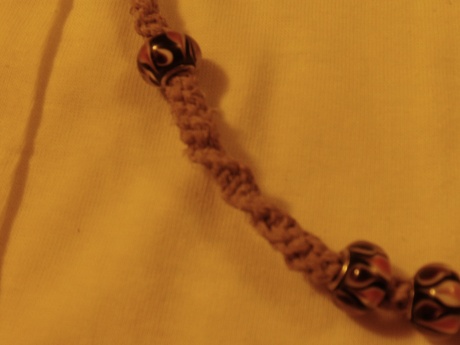
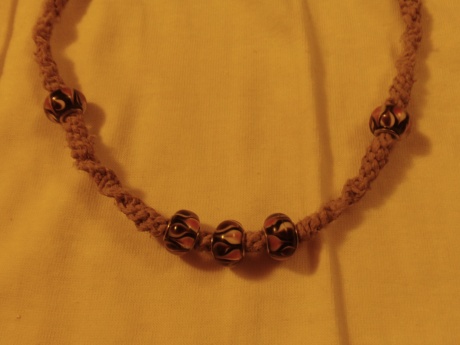
Simple enough. When I wanted to add the spiral knot, I just switched knots. I didn’t put any extra knots in between the monk’s braid and the spiral, although I’m sure it would look a little better if I had. I made sure I did exactly ten knots when using the spiral, just to make sure the spirals were all uniform. As the monk’s braid is more of a “solid” knot than the spiral, it almost seems like the necklace is a little weak where I switch knots. However, I’m sure that will go away after it is worn a few times and broken in. What do you think?
Braiding a Piece of Hemp Jewelry – The Monk’s Braid Knot January 22, 2009
Posted by Rock One in Techniques.Tags: beads, crafts, Handcrafted, hemp, hemp crafts, hemp jewelry, hippy, jewelry, jewelry making, macrame, Techniques
15 comments
The monk’s braid is a knot that I just recently stumbled upon and tried out. From what I gathered, its origins come from the belts of Oriental monks. It’s a pretty cool macrame knot that produces a very stretchy, round, almost rope-like necklace. It looks something like this (don’t mind the beads, I was just playing with different ways to put them on the neckace):
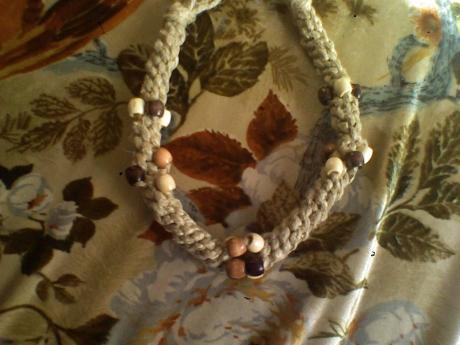
This knot looks pretty complicated, but once you’ve successfully tied it just a few times, it’s relatively easy to do. You’re going to need to cut your cords and tie your starting loop. This one will be done a little differently than you are used to: you will be working from the top of the knot rather than the side. Sit with the knot between your knees. I was going to take pictures for this one, but in all honesty it is much easier to understand when demonstrated in Paint. Set your cords up like this:
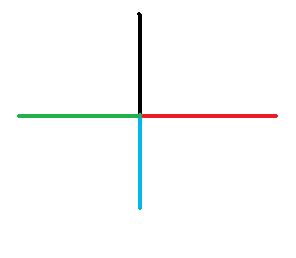
Now, take the top cord, loop it around and over the cord on the right, like this:
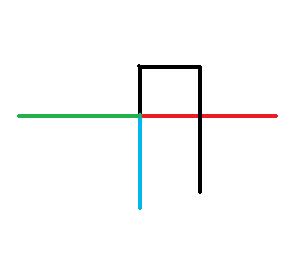
Then, take the cord on the right, and go over both the top and bottom cords:

Keep working clockwise like this, always going over all other cords:
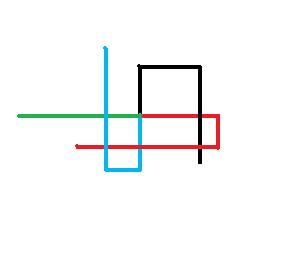
Now, when you get to the last cord, you are going to go over the top cord, then under it, like this:
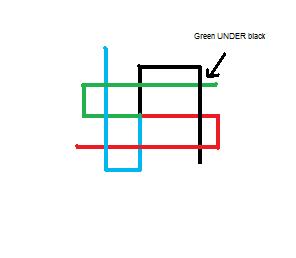
Once your cords look like the picture above, tighten them all by pulling on opposite cords until the cords form sort of a square. Once tight, repeat all the steps again. While this is a fairly simple and cool looking knot, I quickly learned that it takes forever to make a piece of jewelry using it. Worth it, in my opinion, but that’s just me. Probably the simplest way to add a bead would be to just put all four cords through the bead, then continuing knotting. However, I used really thick hemp on this one, and I learned that it looked kind of cool when you put one small bead on each of the four strings, then continuing to knot. Another good thing about this knot is that it doesn’t matter where you start off, because it will turn out exactly the same despite which order you overlap the cords.
This is a pretty unique knot, and I have not seen much (if any) jewelry made using it. Give it a try, and see what you think. Let me know how it turns out. Good luck.
Braiding a Piece of Hemp Jewelry – The Spiral Knot January 22, 2009
Posted by Rock One in Techniques.Tags: beads, crafts, Handcrafted, hemp, hemp crafts, hemp jewelry, hippy, jewelry, jewelry making, macrame, Techniques
add a comment
Besides your basic square knot, the spiral knot is probably the one that I see the most. Although it looks difficult, the truth of the matter is that the spiral knot is just a simplified version of the square knot. While the knot itself is simple, there are a couple of things that make it a bit more complicated that the square knot. One thing I’ve realized is that pieces using the spiral knot look a lot better when made with thicker cord. Also, while I personally like the look of spiral knot pieces with two middle cords, it is possible (and easier) to do it with just one. Keep these in mind when planning your piece.
To start, you will need to cut your four (or three, if you choose) pieces of cord and tie your starting loop. It should look like this:
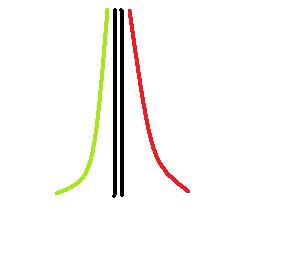
From here, basically everything works like the square knot. Take the left cord over the two middle cords. Then, take the right cord over the left cord, under the two middle cords, and up through the loop created by the left cord, like this:
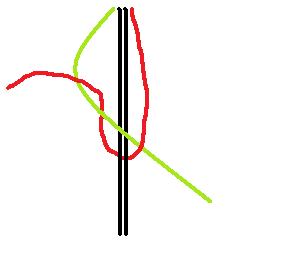
Pull this tight. Now, instead of alternating your braid like you would with the square knot, repeat what you just did. Braid the whole piece with this “left-over-right” technique. Easy, right?
Well, there is one more thing you should keep in mind. While you should generally pull all your knots as tight as you can, if you pull them too tight while using the spiral knot, it will be more difficult. After you have made a few pieces using the spiral knot, try making your knots just a tiny bit looser. When doing this, make sure that you keep the tightness uniform, so the piece doesn’t look unbalanced. Once again, good luck! Let me know if you have any questions, or if my articles are helpful at all. I can always take some actual pictures or video if you need.
Starting and Ending a Piece of Hemp Jewelry January 19, 2009
Posted by Rock One in Techniques.Tags: beads, crafts, Handcrafted, hemp, hemp crafts, hemp jewelry, jewelry, jewelry making
1 comment so far
One of the most basic things to know when making a piece of hemp jewelry is how to start and end it. There are a few different ways to do this, but I am going to demonstrate the way that I do it. It works well for me. Give it a try and see if it does for you.
Starting
To begin, you will need to cut your hemp. Cut two pieces about ten feet long, maybe a little longer. This will ensure that you have enough extra, making sure you don’t run out of hemp half way through a piece. Fold them both exactly in half and place them together, holding them together at the fold like so:
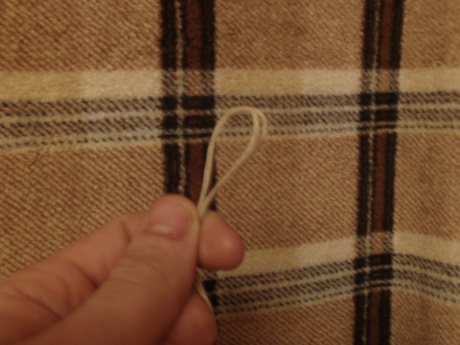
Next, you need tie the cords into a loop. When doing this, keep in mind that this loop will ultimately be used to fasten the piece around your neck (or wrist, or ankle, or whatever else). Don’t make it so small that your ending knot won’t be able to fit through it, but don’t make it so big that it will take a huge knot to fasten. It should look something like this (I know, I would rather have video, too, but I don’t have a tripod for my camera):
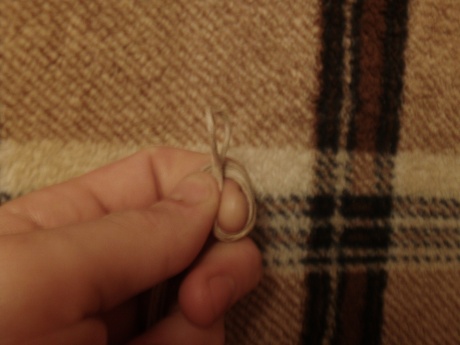
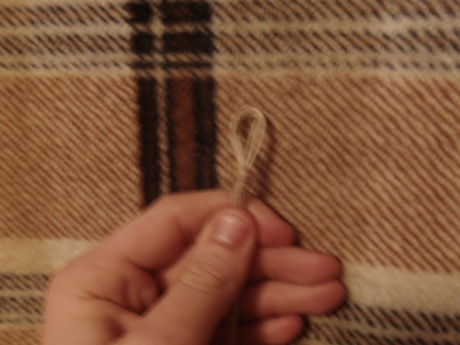 It’s a very simple knot. Just loop it around itself and pull it through. The only thing to keep in mind, as I said before, is to make sure the loop is not too big or small.
It’s a very simple knot. Just loop it around itself and pull it through. The only thing to keep in mind, as I said before, is to make sure the loop is not too big or small.
Ending
Ending a piece is about as easy as starting it. Make sure that the ending knot will fit through your starting loop without falling out.
After you’re done braiding your piece, the two middle pieces of string will be longer than the outside ones. Cut these down so they are all the same length. Once again, loop all four pieces around themselves and pull them through:
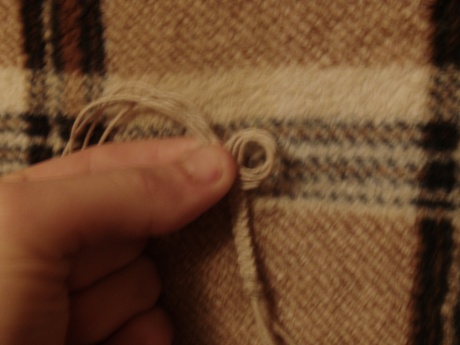
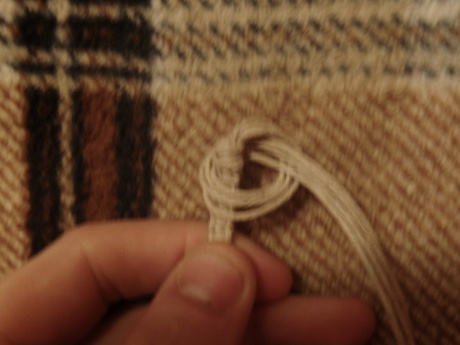
Try to make the knot as close to the piece as possible; that is, you don’t want to see any unbraided cord between the end of the piece and the knot. After the first knot, you will need to (depending on the size of your starting loop) make another knot. Loop all four cords around themselves again and pull them through, making sure that the second knot is just below (and touching) the first. If the knots cover a little of the braided portion of the piece, don’t worry: a little bit of a tug and a little bit of wearing the piece will put it in place. If the knots still don’t fit snugly through your loop, tie another one. Keep doing this until it fits, looping the cords around themselves in the opposite direction as you did the last, and try to make your loop smaller next time.
Cut off the remaining cord after your knot fits through the loop. Make sure you leave just a little bit extra so the knot doesn’t untie after being worn a few times. The finished product should look something like this (although needless to say, a lot longer):
